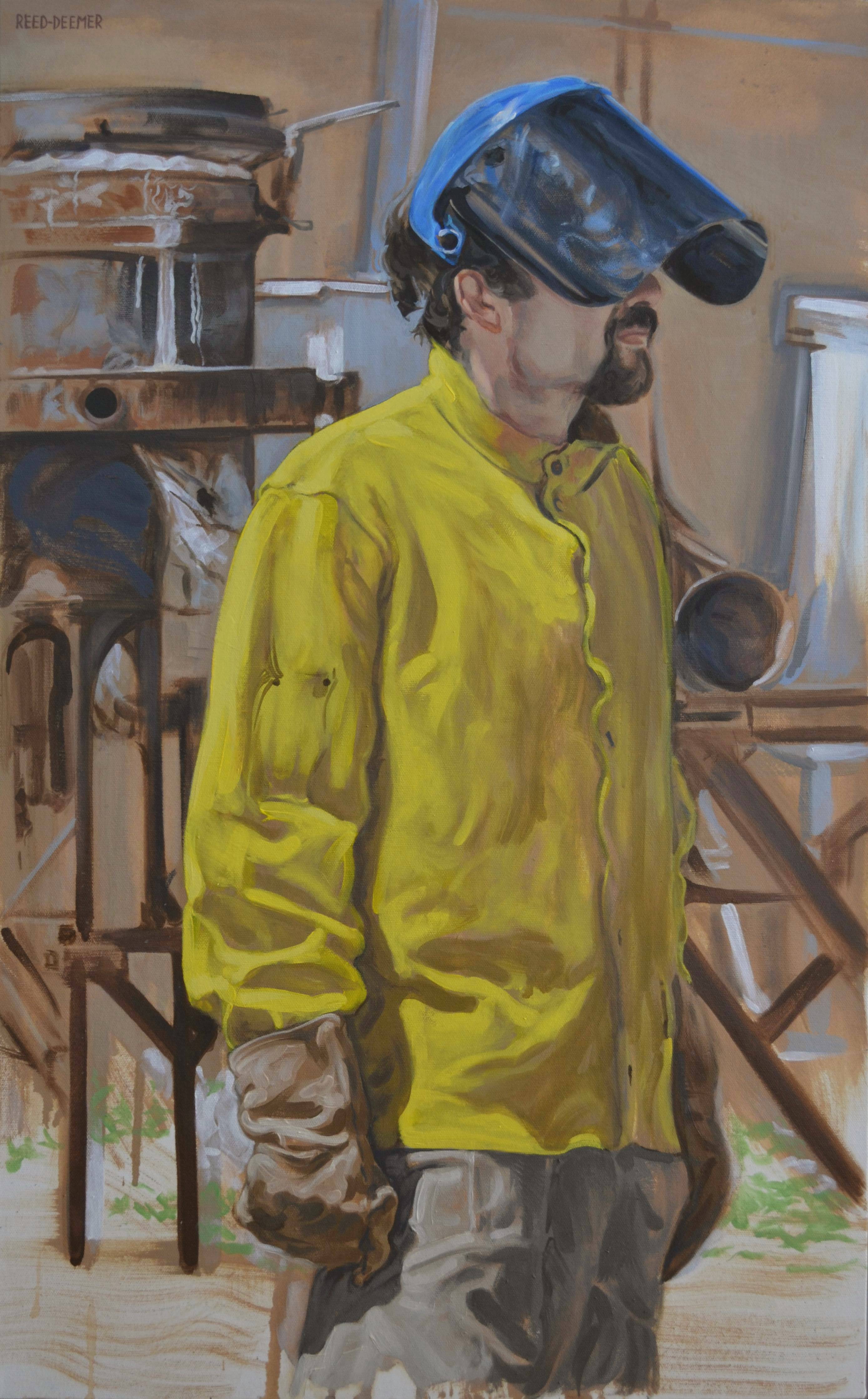Home | About Kimberly | View Artwork | Contact | Resume | Galleries | Links
Kimberly S. Reed-Deemer
What is the Iron Tribe? Why do I paint them?
My interest in and passion for painting the sculptors of New Mexico Highlands University’s art foundry began after I attended one of the art department's Iron Tribe Conferences, an iron pouring event that draws metal sculptors from all over the country and overseas. The first evening of the conference is the night Performance Pour, a choreographed spectacle of molten metal and fire to which the public is invited. I was hooked. My first painting of the Iron Tribe followed shortly thereafter, an action scene depicting the charging of the furnace with fuel, or 'coke.' For a figure painter, the Iron Tribe has it all; people in motion, color, fire, energy and excitement, all in an environment of interesting material and textures. I have a great time with the brushwork and the combination of earthy and bright colors of the welding gear worn by the iron sculptors.
My husband, a sculptor, had enrolled in the metal sculpture classes at NMHU, known as the Iron Tribe, which is how I learned of the iron pours. An iron pour is the art foundry event during which some kind of casting metal (iron, bronze or aluminum) is heated in a furnace, or ‘cupola,’ to a molten state, released into large buckets or crucibles, and poured into specially prepared sculpture molds. Larger furnaces require a team of skilled foundry artists to manage the process. There is a clear division of labor and a hierarchy, with one or more experienced artists directing the pour. Because of the high temperatures involved, heavy protective gear is required from head to foot.
The iron sculptors of New Mexico Highlands University's art foundry call themselves a tribe, and I have come to think of my series of oil paintings depicting them at work as an ethnography in paint. The Association of Qualitative Research defines ethnography as:
“Originating in anthropology, this term traditionally refers to a practice in which researchers spend long
periods living within a culture in order to study it...”
Having trained in
anthropology as well as art, I tend to think about the universals that make us
human in spite of our cultural and individual differences. I respond to
what I see around me, the people I observe, or other aspects of my environment.
I am interested in real people immersed in doing real things, which is why I am drawn
to the NMHU foundry artists. What I choose to paint is still determined by
my own responses to what I have experienced and what I observe, so there is some
degree of subjective interpretation involved. Even so, it sometimes takes an
‘outsider’ to see what is residing below the insiders’ level of conscious awareness.
The iron artists truly are a community, or
'tribe', in the fullest sense. A tribe is a unit of human social
organization based on a number of factors, but generally social or ideological
unity and common cultural practices create the group cohesion. I have come to know many of the foundry sculptors
I’ve painted, and it has been a fascinating experience becoming acquainted with
their world. In this way, I have been allowed to become a ‘participant
observer.’ I have made it my mission to document the Iron Tribe through
the medium of paint rather than the written word as ethnologists do.
While my first painting of the Iron Tribe was a group action scene depicting the charging of the furnace with fuel, after attending a number of iron pours I also began to focus in on the sculptors as individual artists. During iron pours there are stretches of time in between bursts of activity, and I find these down times where the sculptors relax and interact, regroup and recharge, or lose themselves in contemplation of their art as interesting as the action. Artists making art is proving to be an endlessly fascinating subject for my work.
An iron pour serves several important functions. Generating and exhibiting the final products, the finished sculptures, is obviously the goal, but foundry sculptors are extremely "process" oriented, and the pour itself is a powerful social ritual with great or even greater salience for these artists. Unlike other types of artists who can work in solitude in their studios, much of the art foundry sculptors' work requires the group. The success of the pour (and the safety of the pour) depends on cooperation and trust. The Tribe is a diverse structure, involving sculptors of all ages, and both men and women active in a very demanding process that requires strength and responsibility as well as intellect and creativity. There are seasoned elders mentoring mid-level sculptors, and inexperienced novices, including the children of some of the sculptors, so in that respect it is also the passing of ritual, knowledge, and method from one generation to the next. The larger pours and conferences bring together ‘tribes’ of sculptors from other localities, both near and far. The protective gear worn by the foundry artists serves an important utilitarian purpose, but the sculptors go a step further to creatively personalize and enthusiastically embellish their gear with tribe patches, drawings, nicknames, and symbols. Patches are acquired through participation in given iron pours, commemorating these events. Unlike many metal sculptors working today who turn over the wax sculptures they produce in their studios to commercial foundries which actually make the molds, pour the final metal, and apply the finish patination, the Iron Tribe foundry sculptors themselves take their art from first inspiration through molding and casting to the finishing treatments.

IRON ANTICIPATION, 29 x 18 inches, SOLD
| Home | About Kimberly | View Artwork | Contact | Resume | Galleries | Links |